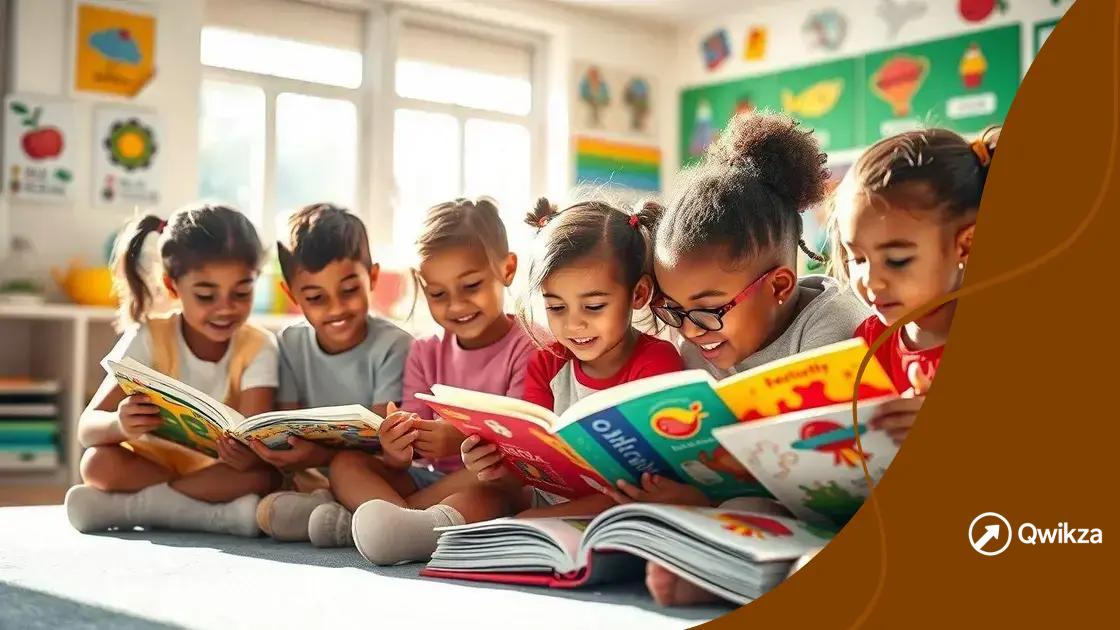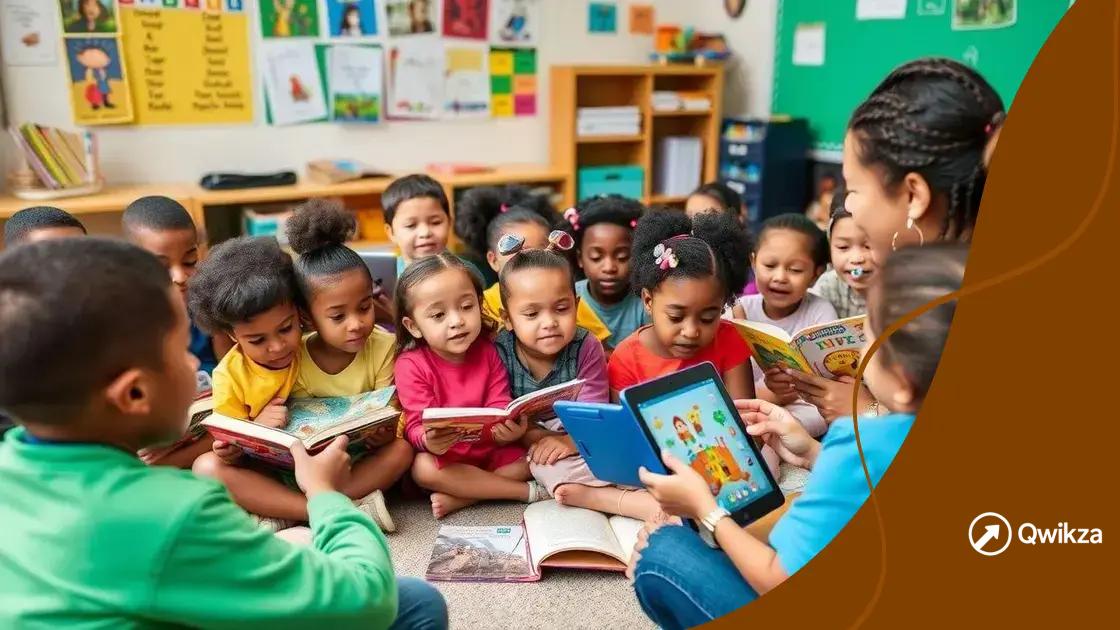Emphasis on literacy and school choice: a vital discussion

Education reform involves addressing challenges like funding inequalities and teacher shortages while promoting innovative solutions such as school choice and community collaboration to enhance literacy and overall student success.
Emphasis on literacy and school choice plays a pivotal role in shaping educational outcomes for students. Have you considered how these factors influence your community and future generations? Let’s delve into their significance.
Understanding the importance of literacy
Understanding the importance of literacy is crucial for every individual and community. It acts as a foundation for lifelong learning and opens doors to opportunities. In today’s world, being literate means more than just reading and writing; it encompasses critical thinking and comprehension skills.
Key Benefits of Literacy
Literacy empowers people in various aspects of their lives. Here are a few vital benefits:
- Improved Communication: Literacy enhances our ability to communicate effectively, both in writing and verbally.
- Increased Employment Opportunities: Many jobs require basic literacy skills, making it essential for career advancement.
- Better Decision Making: Literate individuals can understand information better, leading to informed choices in daily life.
- Enhanced Community Engagement: Reading empowers individuals to participate in community activities and discussions, fostering a sense of belonging.
Moreover, literacy plays an essential role in academic performance. Students with strong literacy skills tend to excel in school. They can navigate through subjects such as math, science, and history with greater ease. Schools that prioritize literacy not only help students achieve better grades but also nurture a love for reading.
Challenges in Achieving Literacy
Despite its importance, many children and adults struggle with basic literacy skills. Factors such as socio-economic status, access to resources, and educational disparities contribute to this issue. Addressing these challenges is imperative for fostering a literate society.
Several initiatives can help improve literacy rates. Community programs can provide reading help, while schools can adopt innovative teaching strategies. Engaging parents in their children’s literacy development is also crucial. By working together, we can create a brighter future where everyone has the opportunity to be literate and thrive.
The impact of school choice on education
The impact of school choice on education is profound and multifaceted. It empowers families to select schools that align with their values and their children’s needs. This freedom can lead to more tailored educational experiences for students.
Benefits of School Choice
There are numerous advantages associated with school choice:
- Personalized Education: Parents can choose schools that specialize in different curriculums, whether it be STEM, the arts, or language immersion.
- Increased Competition: When schools compete for students, they are encouraged to improve their programs, facilities, and overall education quality.
- Access to Quality Education: Families in underserved areas may find options that provide higher quality education, offering better opportunities for their children.
- Enhanced Parental Engagement: Parents become more involved in their children’s education when they have options they care about.
Furthermore, the concept of school choice allows for diverse educational philosophies to flourish. Some schools may emphasize character education, while others focus on academic achievement. This variety means that parents can find a school that fits not only their child’s academic needs but also their values.
Challenges of School Choice
While there are many benefits, school choice can also present challenges. Issues such as funding inequality and limited resources for some schools can create disparities in educational quality. Additionally, transportation barriers may limit accessibility for some families.
Another consideration is the potential impact on neighborhood schools. As students transfer to other options, the resources for local public schools may diminish. It’s a delicate balance that communities must navigate to ensure that all children receive a quality education.
In summary, the impact of school choice on education presents opportunities and challenges. By fostering informed discussions among parents, educators, and policymakers, we can work towards an education system that benefits all students.
Identifying effective strategies for promoting literacy

Identifying effective strategies for promoting literacy is essential for improving educational outcomes. By implementing targeted approaches, communities can help ensure that everyone has access to vital reading and writing skills. These strategies should engage students of all ages and backgrounds.
Proven Literacy Strategies
There are several effective methods to boost literacy rates:
- Early Childhood Education: Programs that focus on literacy from a young age can cultivate a love for reading and establish strong foundational skills.
- Parental Involvement: Encouraging parents to read with their children at home makes a significant difference. This involvement helps create a supportive learning environment.
- Community Reading Programs: Providing access to community libraries and hosting reading events can stimulate interest in books and learning.
- Technology Integration: Utilizing apps and online resources can make reading more engaging for younger generations. Technology can offer personalized learning experiences that cater to individual needs.
Moreover, training teachers to employ diverse instructional techniques can enhance literacy in the classroom. For example, incorporating phonics, vocabulary development, and comprehension strategies can yield positive results. Besides traditional methods, utilizing storytelling and interactive reading sessions can captivate students’ attention.
Creating a Supportive Environment
To further enhance literacy, creating a supportive environment is crucial. Schools should promote a culture of reading by displaying various literature and encouraging book clubs. When students witness their peers enjoying books, they are more likely to engage in reading themselves.
Additionally, mentoring programs can connect struggling readers with peers who can support their literacy journey. By fostering relationships between students, everyone benefits from shared learning experiences. Encouraging collaboration through group reading activities also enhances comprehension and critical thinking skills.
Promoting literacy is a shared responsibility. Schools, families, and communities must work together, recognizing that each individual plays a role in this essential mission.
Real-life success stories in literacy and school choice
Real-life success stories in literacy and school choice can inspire communities and highlight the transformative power of education. These stories show how individuals and families have benefited from making informed choices about their educational journeys.
Case Study 1: Emily’s Journey
Emily, a third grader, struggled with reading at her local public school. After her parents explored options, they enrolled her in a charter school that focused on literacy development. The school emphasized personalized learning and provided additional resources for struggling readers.
With the help of dedicated teachers and a reading mentor, Emily’s skills improved significantly. By the end of the school year, she was reading at grade level and developed a passion for books. Her story illustrates how school choice can lead to successful literacy outcomes.
Case Study 2: The Johnson Family
The Johnson family moved to a new city and found themselves facing challenges in accessing quality education. They were overwhelmed by the options available, but decided to visit several schools in the area. After thorough research, they chose a school known for its strong commitment to literacy programs.
Their children thrived in an environment that encouraged reading and writing through creative assignments and projects. The impact was evident; not only did their academic performance improve, but they also became more engaged in their education.
Success with Community Initiatives
Many communities have implemented literacy initiatives that have yielded impressive results. For instance, a local library established a reading program where volunteers read with children weekly. This program not only boosted literacy rates but also fostered a love for reading.
Another effort involved local schools partnering with organizations to create after-school tutoring programs focused on literacy. Students from underserved backgrounds received personalized attention, which significantly contributed to their reading skills and overall academic success.
These success stories demonstrate that with the right resources and support, literacy can flourish through school choice and community involvement. They remind us that every child deserves the opportunity to succeed.
Challenges and solutions in education reform
Challenges and solutions in education reform are critical topics that need to be addressed to improve learning outcomes for all students. Various obstacles hinder progress, yet innovative solutions can break down these barriers.
Key Challenges in Education Reform
Several significant challenges affect educational systems:
- Funding Inequalities: Disparities in funding among schools often lead to unequal resources. Schools in wealthier areas may have access to better facilities and programs compared to those in low-income neighborhoods.
- Teacher Shortages: Many regions face a shortage of qualified teachers. This can result in overcrowded classrooms and less individualized attention for students.
- Standardized Testing Pressure: High-stakes testing can create stress for students and teachers. It may lead to a narrow focus on test preparation rather than holistic learning.
- Resistance to Change: Educational reform often meets resistance from various stakeholders, including parents, teachers, and policymakers who may be hesitant to adopt new methods or curricula.
Addressing these challenges is essential for fostering an effective learning environment. For instance, communities can advocate for equitable funding models that ensure every school receives the necessary resources.
Innovative Solutions
There are promising solutions that can help overcome the challenges faced in education reform. Schools can implement community partnerships that focus on student needs, creating programs that engage families and support learning outside the classroom. For example, tutoring programs that connect volunteers with students can make a significant impact.
Furthermore, prioritizing teacher professional development helps educators adapt to changing educational landscapes. Providing training on new technologies and teaching methods can empower teachers and improve classroom experiences.
Additionally, incorporating personalized learning approaches allows educators to tailor instruction to meet the diverse needs of their students. By focusing on individual strengths and weaknesses, teachers can foster a more engaging and effective learning environment.
FAQ – Frequently Asked Questions about Education Reform and Literacy
What are the main challenges in education reform?
The main challenges include funding inequalities, teacher shortages, standardized testing pressure, and resistance to change.
How can communities support literacy programs?
Communities can support literacy programs by establishing reading initiatives, providing resources, and encouraging parental involvement.
What role does school choice play in improving education?
School choice allows families to select schools that best fit their children’s needs, promoting diversity in educational approaches and fostering competition.
What innovative solutions exist to enhance literacy?
Innovative solutions include personalized learning approaches, community partnerships, and technology integration to make learning more engaging and effective.
